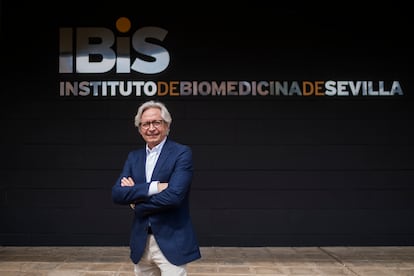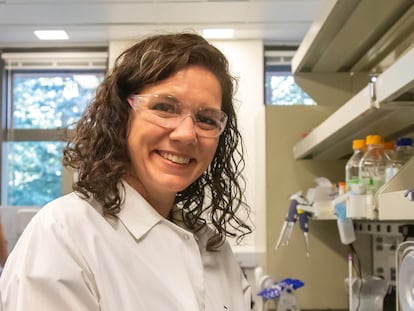‘Women age twice as fast due to a lack of estrogen’
Gynecologist Guillermo Antiñolo is developing the first female medical genome according to women’s specific biological condition to be mothers

Guillermo Antiñolo, 66, defines women poetically as “the South in flesh.” Behind his description lie decades studying women’s health as professor of Obstetrics and Gynecology, hospital director of the Department of Maternal-Fetal Medicine, Genetics and Reproduction and researcher of the genome – the complete genetic material contained in the chromosomes of an organism. If genes are considered the pieces of a puzzle, the genome is the completed puzzle. However, although we have a high percentage of this puzzle in common, each individual is different and it is in these slight differences that the keys to health lie.
So far, we have a general picture of what the human genome should be like. It is a picture that allows us to assemble the puzzle or detect erroneous, missing or excess pieces. However, women and men are biologically different and there is a lack of specific female models to allow us to identify unique biomarkers – genomic variants associated with a clinical trait that would explain, for example, causes of infertility, endometriosis and various types of cancer, as well as enabling us to specifically address issues linked to pregnancy and the climacteric period (menopause, including pre- and post-). According to Antiñolo, identifying them would enable advances in terms of health, social and psychological well-being, as well as boosting the efficiency of the healthcare system.
This is the so-called “twilight” project on which this scientist, who is listed among the 100 best doctors in Spain, has embarked. With the collaboration of Clínicas and Fundación Ginemed, his team has gathered genetic material from 1,000 healthy women and has so far sequenced material from 300 in order to piece together the first female medical genome. The images of female genomic variability will serve as a reference when addressing pathologies or physiological processes associated with their biological condition. Funding of between €300,000 and €500,000 (327,000-545,000 dollars) is still needed to complete this first phase, which, he says, will have extensive applications.
Question. How did the the first medical female genome project arise?
Answer. Clinical trials are done on men and their information is transferred to women. But women, from the biological point of view – and like all other mammals – are designed to be mothers and have a programmed obsolescence that is linked to the loss of ovarian function. Not everyone realizes this, but it is a fundamental reality. Infertility in women or the climacteric period has to do with ovarian function – and estrogen production: women stop producing oocytes, cease to be potential mothers and no longer produce estrogen. But it turns out that estrogen is the central axis of their metabolism and that is why women age in a different way: they age twice as fast due to the lack of estrogen. Some cancers and metabolic diseases also have to do with the failure of ovarian function. The woman who serves as a genomic model must have her ovarian function intact and her estrogen functioning in a normal physiological manner. This may seem like a no-brainer, but it is actually not if we are talking about controls for genomic variability in women.
Q. But the female genome has been sequenced.
A. Female reference genomes do not reflect their organ function. Ours is the first research to look at normal ovarian function as one of the central elements of genomic variability. We have generated a cohort of almost 1,000 individuals who can be followed over time, and who start from a basic, female physiological condition. This has never been done before.
Q. Why has it not been done before?
A. There is a problem regarding fragmented information. Half of the data we have are from women, that’s true, but it is not the same, because the phenotype is looked at in the same way as the phenotype of men and fertility has a lot to do with women’s overall health, making it a determining factor. Our approach aims to establish a female genomic variability reference of women who are strictly normal, with normal ovarian function.
Q. What applications does this female normality have for the reference genome?
A. For example, when it comes to identifying a gene sequence that could lead to a pathology. What we have now is a frame of reference, canonical standards, a Vitruvian model [Leonardo da Vinci’s drawing of the ideal proportion of a human figure] that is fundamentally androcentric [centered on men], like almost all medicine, and does not consider the physiology of women as a differentiating factor. I am looking for our model to be “perfection” in genomic variability so that, when compared with that of a woman experiencing infertility, cancer, cardiovascular disease or other conditions, our reference genome is that of women who started life normal, with identical baseline conditions based on normal ovarian function. We are working to generate a larger cohort, and also towards other international groups entering with the same holistic concept of women. It’s not the concept that men have of women or of their health, or that even women have of their own health, because women do not contemplate their own health as factually different.
Q. You’re saying women not aware of this difference?
A. It is a health determinant linked to health problems in the second or third stage of life, such as cancer, obesity, metabolism, early menopause. But we are androcentric. Even women, sometimes, are androcentric in terms of health. They forget about biology because we have entered an essentially social and economic world, but in terms of health, biology matters a lot: women are mothers and they have a programmed obsolescence. Women live longer because they have fewer toxic habits than men do, though their longevity will be increasingly similar to men’s as they acquire the same toxic habits. But I’m not just talking about enduring, I’m talking about living. These are two different concepts. Living, quality of life, diseases and the response to these are determined by the function of estrogen.
Q. Are you saying that women last longer, but with a poorer quality of life?
A. Basically, yes, because they do not have estrogen and estrogen determines all the changes as they enter later life stages. Women age twice as fast as men from the menopause onwards – from the moment they lose estrogen. Hormone replacement therapy does not work for all women. It is a therapy that you have to personalize. But it can radically change a woman’s perspective and the perspective of her health. Estrogen determines a woman’s normal metabolism; it is central to cognitive development, to immune function, to cardiovascular function, to hyperlipidemia and vaginal atrophy.
Q. Can the problems associated with menopause be corrected?
A. Women are now treated with estrogen, simulating the biological function without the ovarian component, which today is irreplaceable. When it comes to diabetes, no one thinks of ditching the use of insulin and telling the patient to just do gymnastics and go to a psychologist. Women are told all sorts of things because the menopause is considered normal, but healthy aging is a completely different concept and it is not achieved only with gymnastics or going to the psychologist.
Q. How is the project going?
A. We already have data on 1,000 women, but we have only sequenced a part of it because we ran out of funding. I am waiting for projects to come out now and looking for private initiatives in order to finance the programs. It is possible that I will present the project to the European Parliament as a different vision of science. The collaboration with Ginemed has been definitive because they have a program of oocyte donation – of egg donors – which is critical from the point of view of what I was looking for: normal ovarian function.
We have clinical information that we wouldn’t otherwise have and an assurance that this has to do with fertility. The data have been put into IMPaCT [Infrastructure for Precision Medicine associated with Science and Technology] and we have a Beacon [a rapid genomic variant search tool], the first in the world on female genome with these characteristics, with which to compare an anonymous sequence with a variation that may be related to a disease. If it has a clinical impact or we think it may have one, then we can open up a space for collaboration. To complete the first Spanish phase, we need financing of between €300,000 and €500,000 (327,000-545,000 dollars).

Q. How can a woman’s medical genome be used?
A. The immediate applications are extensive regarding short-term problems in women, such as endometriosis, for example. Then there’s the generation of pharmacogenomics for fertility as well as a number of problems related to women’s health. Later on we will see how they can be applied to cardiovascular disease or other conditions. But for that we will need samples from women who have the condition in question and we have only worked to generate a prototype. We will have to see how different women’s pathologies fit that prototype. But I want to insist on one thing: we are not just talking about a specific pathology affecting women. Many problems can be related to estrogen function and ovarian function of the physiologically normal woman. Later on, these can provide us with therapeutic targets by knowing how the genomic prototype behaves with specific pathologies. We are now starting a project where, based on the reference genomes established, we are going to determine elements that predict risk from the beginning of pregnancy. If we have genomic indicators that compare our absolutely normal reference population with women who already have a fertility problem, we will surely find things that will allow us to anticipate and establish elements that can be treated.
Q. Is the difference between men and women so great?
A. When women reach the menopause, their entire physiology is transformed and yet we perceive them to age like men. Men have andropause, but that is irrelevant. The function of androgens is completely different. Androgens are important for everyone, both men and women, but they do not establish a life cycle as estrogen does in women. Men age because of habits, because of a sedentary lifestyle, just as women do, but women also age because they lose their physiological centrality. I am trying to create a genomic Metoo [the feminist movement], to bring the fact that women are not like us to the fore; to introduce it into the general context of science. Women need a different approach. What I wanted to do was to flag up the need for a different reference, not just from the general field of science, because women are different from an essentially biological point of view. It should be a scientific trend to include women in projects in a holistic way and from their normal biology, not in the manner in which it has been done to date.
Sign up for our weekly newsletter to get more English-language news coverage from EL PAÍS USA Edition










































